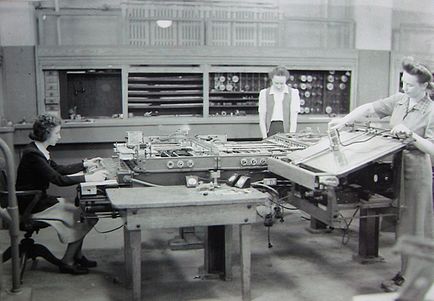
Kathleen Rita McNulty was born in the village of Creeslough on February 12, 1921, the third of six children of Anne Nelis and James McNulty. Her father was Commandant of the Doe Battalion of the Irish Volunteers. On the night of her birth, he was arrested and imprisoned in Derry Gaol for two years for his republican activities. On his release, the family emigrated to the United States and settled in Philadelphia, Pennsylvania, where James worked as a stonemason and went on to establish a successful construction business, frequently working with Irish American John B Kelly, the father of the future Oscar-Winning actress Grace,
Coming from the Gaeltacht, Kathleen did not start speaking English until she began to attend school. Her mother encouraged her “to prove that Irish immigrants could be as good, if not better, than anybody.” She proved a bright student and won a scholarship to Chestnut Hill College.
Kathleen loved mathematics and took every math course available, including spherical trigonometry, differential calculus, projective geometry, partial differential equations, and statistics. McNulty graduated as one of the school’s few female math majors in 1942.

Graduating at the height of WW II, she soon saw an ad in the Philadelphia Inquirer seeking women with math backgrounds. The U.S. Army was seeking women to perform the grueling and precise calculations to compile firing tables for long-range guns, calculations that needed to be accurate out to ten decimal places. Kathleen was hired with the official job title of “Computer.”
Within a few months, McNulty was transferred to work with the “differential analyser[sic]” at the Moore School of Engineering at the University of Pennsylvania. The “analyser” was the most sophisticated calculator of the time. Using the “analyser,” a single trajectory that had previously taken 50 hours to compute by hand could now be performed in less than one hour. Kathleen excelled at the detailed, meticulous work and was soon promoted to supervising calculations. She and other staff members worked six days a week, with the only holidays being Christmas and the Fourth of July.

In 1945, Kathleen and five other women were selected to work at the Aberdeen Proving Grounds in Maryland to develop the programs to run the top-secret 30-ton machine called the Electronic Numerical Integrator and Computer (ENIAC), the world’s first programmable, electronic, general-purpose digital computer.. ENIAC could perform the calculations that took the “analyser” an hour in less than ten seconds but would require developing a brand-new engineering discipline: Software Engineering. McNulty is credited with creating “the subroutine,” a block of reusable computer code that can be used again and again rather than being rewritten over and over, to work past some of the limitations of ENIACs early logic circuits. McNulty would later recall that in making ENIAC a success as the first digital computer, she made herself “the human computer” obsolete.
With the end of WW II, the vital role that Kathleen McNulty and her fellow women “computers” was soon unceremoniously and unjustly forgotten. When the decision was made to reveal ENIAC as the first digital computer to the world, the role of Kathleen and the other women played in making ENIAC successful was relegated to the shadows. They were told to act as hostesses to the government officials and reporters covering the event and to “stand by the computer and look good.”
Kathleen McNulty married ENIAC’s designer Mauchly and went on to have five children with him (in addition to raising two from his previous marriage). While she continued to contribute to the field of computer science, programming several of her husband’s later computers, it was always behind the scenes. After Mauchly’s death, she late married Severo Antonelli.
Kathleen McNulty Mauchly Antonelli died on April 20, 2006. She had come along way from the little Irish girl who had come to America not speaking English, and in the process, shaped the digital world we now live in. She deserves to be better remembered, and this is why we have and need Irish American Heritage Month.
THIS IRISH AMERICAN HERITAGE MONTH PROFILE IS PRESENTED BY THE ANCIENT ORDER OF HIBERNIANS (AOH.COM)
#IrishAmericanHeritageMonth
Neil F. Cosgrove ©